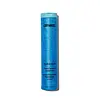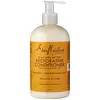What's inside
What's inside
 Key Ingredients
Key Ingredients

 Benefits
Benefits

 Concerns
Concerns

 Ingredients Side-by-side
Ingredients Side-by-side

Water
Skin ConditioningCetearyl Alcohol
EmollientIsopropyl Palmitate
EmollientCapryloyl Glycerin/Sebacic Acid Copolymer
Skin ConditioningBehentrimonium Chloride
PreservativeDiheptyl Succinate
EmollientQuaternium-91
Persea Gratissima Oil
Skin ConditioningSqualane
EmollientHippophae Rhamnoides Fruit/Seed Oil
AntimicrobialBrassica Campestris Seed Oil
Skin ConditioningSesamum Indicum Seed Oil
EmollientCocos Nucifera Oil
MaskingSodium Hyaluronate
HumectantPolyglutamic Acid
Skin ConditioningSpirulina Platensis Extract
Skin ProtectingCocos Nucifera Water
MaskingEmblica Officinalis Fruit Extract
Skin ConditioningCurcuma Longa Root Extract
MaskingButyrospermum Parkii Butter
Skin ConditioningLeuconostoc/Radish Root Ferment Filtrate
AntimicrobialGlycerin
HumectantBehentrimonium Methosulfate
PPG-3 Benzyl Ether Myristate
EmollientGuar Hydroxypropyltrimonium Chloride
Skin ConditioningPolyquaternium-37
Polyquaternium-73
Propylene Glycol Dicaprylate/Dicaprate
EmollientPolyquaternium-7
Ethylhexylglycerin
Skin ConditioningTetrasodium Glutamate Diacetate
PPG-1 Trideceth-6
Skin ConditioningSodium Hydroxide
BufferingSodium Chloride
MaskingIsopropyl Alcohol
SolventCitric Acid
BufferingPotassium Sorbate
PreservativeSodium Benzoate
MaskingPhenoxyethanol
PreservativeParfum
MaskingBenzyl Benzoate
AntimicrobialHydroxycitronellal
PerfumingLimonene
PerfumingWater, Cetearyl Alcohol, Isopropyl Palmitate, Capryloyl Glycerin/Sebacic Acid Copolymer, Behentrimonium Chloride, Diheptyl Succinate, Quaternium-91, Persea Gratissima Oil, Squalane, Hippophae Rhamnoides Fruit/Seed Oil, Brassica Campestris Seed Oil, Sesamum Indicum Seed Oil, Cocos Nucifera Oil, Sodium Hyaluronate, Polyglutamic Acid, Spirulina Platensis Extract, Cocos Nucifera Water, Emblica Officinalis Fruit Extract, Curcuma Longa Root Extract, Butyrospermum Parkii Butter, Leuconostoc/Radish Root Ferment Filtrate, Glycerin, Behentrimonium Methosulfate, PPG-3 Benzyl Ether Myristate, Guar Hydroxypropyltrimonium Chloride, Polyquaternium-37, Polyquaternium-73, Propylene Glycol Dicaprylate/Dicaprate, Polyquaternium-7, Ethylhexylglycerin, Tetrasodium Glutamate Diacetate, PPG-1 Trideceth-6, Sodium Hydroxide, Sodium Chloride, Isopropyl Alcohol, Citric Acid, Potassium Sorbate, Sodium Benzoate, Phenoxyethanol, Parfum, Benzyl Benzoate, Hydroxycitronellal, Limonene
Water
Skin ConditioningStearyl Alcohol
EmollientOlea Europaea Fruit Oil
MaskingBehentrimonium Chloride
PreservativeCetyl Alcohol
EmollientButyrospermum Parkii Butter
Skin ConditioningGlyceryl Caprylate
EmollientArgania Spinosa Kernel Oil
EmollientMacrocystis Pyrifera Extract
Skin ConditioningSimmondsia Chinensis Seed Oil
EmollientDaucus Carota Sativa Seed Oil
EmollientHydrolyzed Silk
HumectantHydrolyzed Soy Protein
HumectantAloe Barbadensis Leaf Juice
Skin ConditioningPanthenol
Skin ConditioningTocopheryl Acetate
AntioxidantDicaprylyl Ether
EmollientSodium Isostearoyl Lactylate
EmulsifyingSodium Benzoate
MaskingHydroxyethylcellulose
Emulsion StabilisingGlyceryl Undecylenate
EmollientParfum
MaskingWater, Stearyl Alcohol, Olea Europaea Fruit Oil, Behentrimonium Chloride, Cetyl Alcohol, Butyrospermum Parkii Butter, Glyceryl Caprylate, Argania Spinosa Kernel Oil, Macrocystis Pyrifera Extract, Simmondsia Chinensis Seed Oil, Daucus Carota Sativa Seed Oil, Hydrolyzed Silk, Hydrolyzed Soy Protein, Aloe Barbadensis Leaf Juice, Panthenol, Tocopheryl Acetate, Dicaprylyl Ether, Sodium Isostearoyl Lactylate, Sodium Benzoate, Hydroxyethylcellulose, Glyceryl Undecylenate, Parfum
 Reviews
Reviews

Ingredients Explained
These ingredients are found in both products.
Ingredients higher up in an ingredient list are typically present in a larger amount.
This ingredient is a preservative and often used for it's anti-static properties. You'll most likely see this ingredient in hair conditioners.
It does not cause irritation or sensitization in leave-on products at 1-5%.
This ingredient is also known as shea butter. It is an effective skin hydrator and emollient.
Emollients help soothe and soften your skin. It does this by creating a protective film on your skin. This barrier helps trap moisture and keeps your skin hydrated. Emollients may be effective at treating dry or itchy skin.
Shea butter is rich in antioxidants. Antioxidants help fight free-radicals, or molecules that may harm the body. It is also full of fatty acids including stearic acid and linoleic acid. These acids help replenish the skin and keep skin moisturized.
While Shea Butter has an SPF rating of about 3-4, it is not a sunscreen replacement.
Shea butter may not be fungal acne safe. We recommend speaking with a professional if you have any concerns.
Learn more about Butyrospermum Parkii ButterParfum is a catch-all term for an ingredient or more that is used to give a scent to products.
Also called "fragrance", this ingredient can be a blend of hundreds of chemicals or plant oils. This means every product with "fragrance" or "parfum" in the ingredients list is a different mixture.
For instance, Habanolide is a proprietary trade name for a specific aroma chemical. When used as a fragrance ingredient in cosmetics, most aroma chemicals fall under the broad labeling category of “FRAGRANCE” or “PARFUM” according to EU and US regulations.
The term 'parfum' or 'fragrance' is not regulated in many countries. In many cases, it is up to the brand to define this term.
For instance, many brands choose to label themselves as "fragrance-free" because they are not using synthetic fragrances. However, their products may still contain ingredients such as essential oils that are considered a fragrance by INCI standards.
One example is Calendula flower extract. Calendula is an essential oil that still imparts a scent or 'fragrance'.
Depending on the blend, the ingredients in the mixture can cause allergies and sensitivities on the skin. Some ingredients that are known EU allergens include linalool and citronellol.
Parfum can also be used to mask or cover an unpleasant scent.
The bottom line is: not all fragrances/parfum/ingredients are created equally. If you are worried about fragrances, we recommend taking a closer look at an ingredient. And of course, we always recommend speaking with a professional.
Learn more about ParfumSodium Benzoate is a preservative. It's used in both cosmetic and food products to inhibit the growth of mold and bacteria. It is typically produced synthetically.
Both the US FDA and EU Health Committee have approved the use of sodium benzoate. In the US, levels of 0.1% (of the total product) are allowed.
Sodium benzoate works as a preservative by inhibiting the growth of bacteria inside of cells. It prevents the cell from fermenting a type of sugar using an enzyme called phosphofructokinase.
It is the salt of benzoic acid. Foods containing sodium benzoate include soda, salad dressings, condiments, fruit juices, wines, and snack foods.
Studies for using ascorbic acid and sodium benzoate in cosmetics are lacking, especially in skincare routines with multiple steps.
We always recommend speaking with a professional, such as a dermatologist, if you have any concerns.
Learn more about Sodium BenzoateWater. It's the most common cosmetic ingredient of all. You'll usually see it at the top of ingredient lists, meaning that it makes up the largest part of the product.
So why is it so popular? Water most often acts as a solvent - this means that it helps dissolve other ingredients into the formulation.
You'll also recognize water as that liquid we all need to stay alive. If you see this, drink a glass of water. Stay hydrated!
Learn more about Water